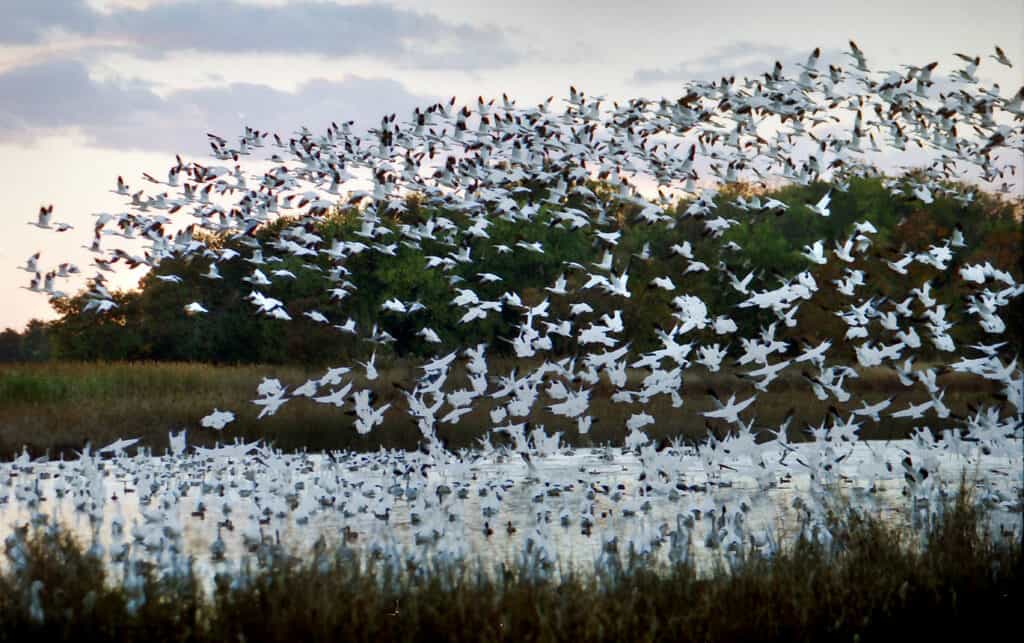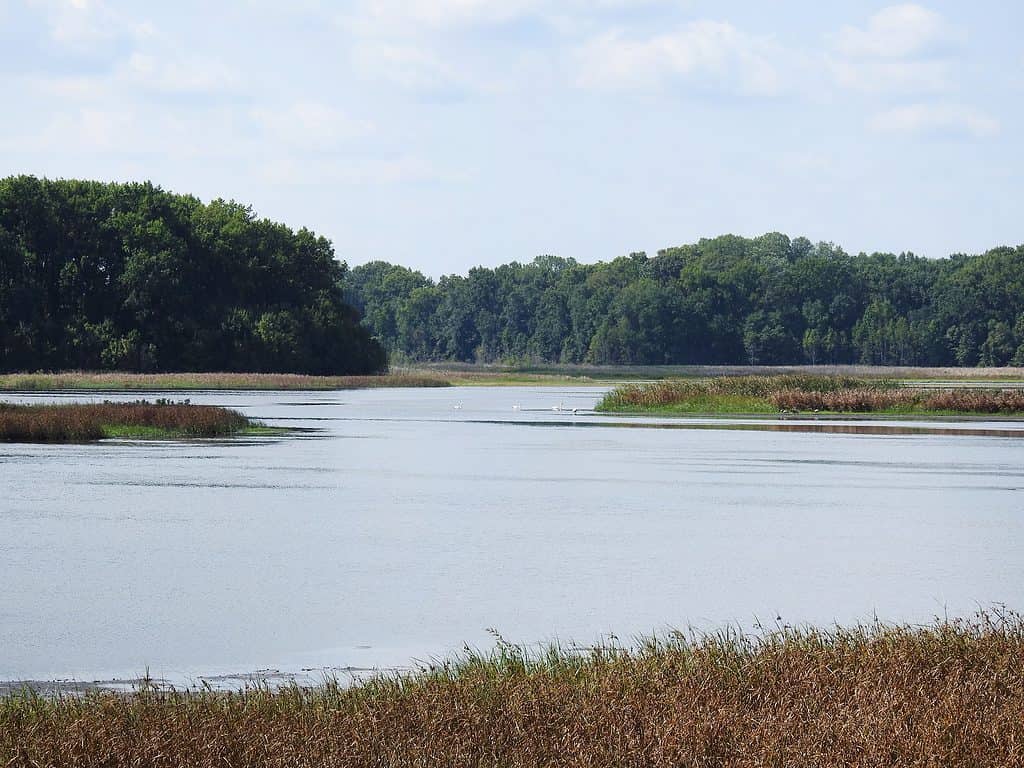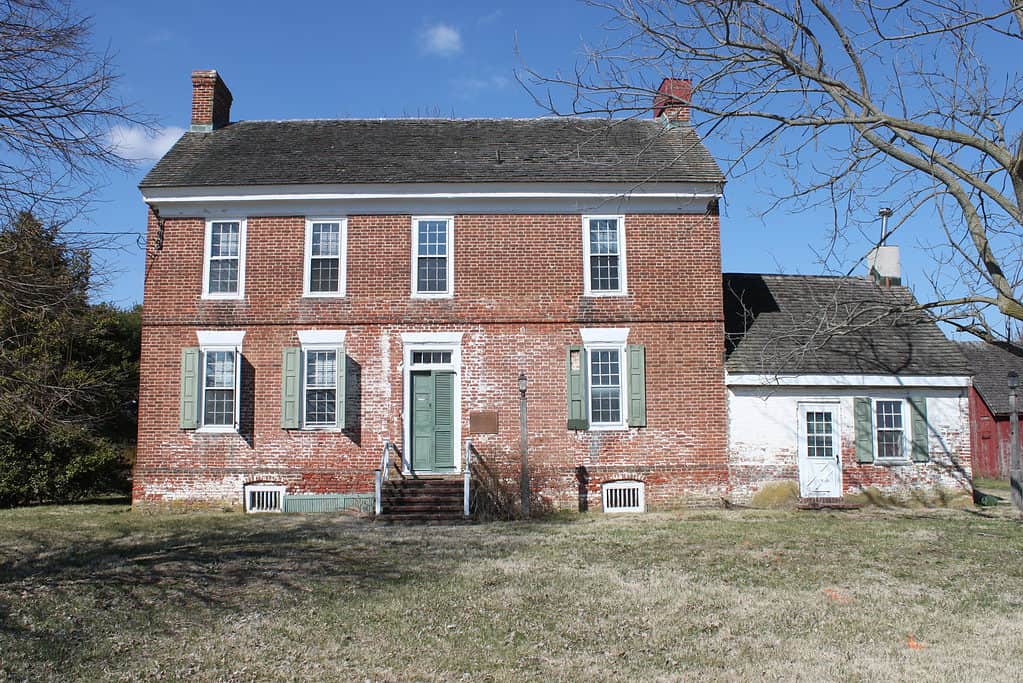Located inside the Bombay Hook National Wildlife Refuge, Shearness Pool is the largest man-made lake in Delaware. This man-made freshwater impoundment has a surface area of 203 acres. At that size, it ranks not only as the largest man-made lake but the overall largest freshwater lake in Delaware. The pond is home to over 350 different bird species, making it a haven for bird watchers and nature enthusiasts.
Don’t let its name fool you, Shearness Pool is no small body of water. In Delaware, the term “pool” or “pond” works as a substitute for “lake.” The next largest body of water in the state, Lums Pond, measures only slightly smaller at 200 surface acres. That said, Shearness Pool doesn’t measure as deep as other lakes in Delaware. Unlike other man-made lakes in the state, which were made for boating, fishing, or to hold freshwater reserves, Shearness Pool was designed to be used as a wildlife refuge. Shearness Pool measures 2 or 3 feet deep in most spots, which makes it an ideal location for wading birds. Compared to the 12-foot deep Millsboro Pond – the deepest lake in Delaware, Shearness Pool looks woefully shallow.
Shearness Pool rests within the 15,978-acre Bombay Hook National Wildlife Refuge in Kent County, Delaware. The refuge consists mostly of tidal salt marshes and represents an important habitat for resident and migratory birds. Every year, thousands of birds arrive to overwinter or rest for a few weeks at Shearness Pool or one of the 3 other pools in the refuge. The wide range of bird species that visit the refuge make it a must-visit spot for birders. In addition to birds, the refuge also supports many other animal species. Some animals you can spot in the refuge include rabbits, woodchucks, foxes, deer, beavers, otters, opossums, and muskrats. In and around Shearness Pool you can also spot salamanders, frogs, turtles, snakes, and lizards. You can explore the refuge by car or travel its trails on foot.

Thousands of birds overwinter or rest for a few weeks at Shearness Pool or one of the 3 other pools in the Bombay Hook National Wildlife Refuge.
©iStock.com/bilbowden
History of Shearness Pool
Before Bombay Hook National Wildlife Refuge was created, the area around Shearness Pool was untamed marshlands. For hundreds of years, Native American tribes referred to the area as Canaresse, or “at the thickets.” The name Bombay Hook comes from the Dutch Boompjes Hoeck, meaning “little-tree point.” Dutch settler Peter Bayard bought the land around modern-day Shearness Pool from the chief of Kahansink, Mechacksett, in 1679 for a handful of household goods and a gun and powder.
A few years later, in 1682, a canal constructed between Smyrna and Delaware Bay led to the development of the Smyrna River. Development of the land continued when Abraham Allee built a farmhouse in the area in 1753. The farmhouse still stands in the refuge to this day and serves as a prime example of what life was like in pre-revolutionary America. Several other developments on the land took place over the decades, including the construction of the Bombay Hook lighthouse in 1831 and a hotel on Bombay Hook Island in 1848.
In 1938, the Civilian Conservation Corps (CCC) began to work on the project that would eventually turn into the Bombay Hook National Wildlife Refuge. A government work relief program started by President Franklin D. Roosevelt in 1933, the CCC teams based in Leipsic Delaware were instrumental in developing Shearness Pool. They cleared the woodlands in the area and built a dike that impounded the water needed to create Shearness Pool and the other pools in the refuge. Additionally, the CCC planted over 50,000 trees, dug ditches for mosquito control, and constructed several buildings in the refuge, including a boathouse, marine railway, observation tower, and headquarters.
Today, Shearness Pool and all of Bombay Hook serve as important breeding and feeding grounds for waterfowl and migratory birds. The land also supports research efforts to study animals ranging from bald eagles to horseshoe crabs. Due to its importance to nearly 350 bird species, Bombay Hook is recognized as a Ramsar Wetland of International Importance and a Globally Important Bird Area. It also belongs to the New England/Mid Atlantic Coast Bird Conservation Region Implementation Plan.

Located inside the Bombay Hook National Wildlife Refuge, Shearness Pool is the largest man-made lake in Delaware.
©Scenic Corner/Shutterstock.com
Shearness Pool Geography
Shearness Pool resides in Kent County in northeastern Delaware, just a few miles inland from Delaware Bay. The Leipsic River feeds into Shearness Pool on its southern shore, while Duck Creek flows out from its eastern shore toward the bay. Authorities manipulate the water levels in the pool to produce adequate amounts of vegetation for waterfowl. Additionally, the winding paths of the Leipsic River and Duck Creek make excellent habitats for birds and other wildlife.
The small town of Leipsic lies just to the southwest of Shearness Pool, while the town of Smyrna is located to the northwest. Most of the land surrounding Shearness Pool consists of tidal salt marsh intersected by the Leipsic River and Duck Creek. These waterways also feed three other impoundments in the Bombay Hook National Wildlife Refuge: Raymond Pool, Finis Pool, and Bear Swamp Pool. A small amount of the land in the refuge (around 1,100 acres) is set aside for upland agricultural crops. These crops provide additional food for the waterfowl and migratory birds that visit the refuge.
Several facilities and points of interest dot the landscape around Shearness Pool. Bombay Hook National Wildlife Refuge features a visitor center and several observation towers. You can travel the refuge along its 12-mile auto tour route or one of its 5 nature trails. The trails vary between 0.25 and 1 mile and feature blinds that visitors can use to discreetly watch wildlife. A short distance from the pool rests the Bombay Hook lighthouse, also known as the Smyrna lighthouse. Finally, the historical Allee House stands within the confines of the refugee. Constructed in 1753 by Abraham Alee, this pre-revolutionary war farmhouse is listed on the National Register of Historic Places.

Within the refuge stands the historical Allee House constructed in 1753 by Abraham Alee and listed on the National Register of Historic Places.
©GB fan, CC BY-SA 3.0 <https://creativecommons.org/licenses/by-sa/3.0>, via Wikimedia Commons – License
Shearness Pool Reviews
Overall, reviews of Shearness Pool and Bombay Hook National Wildlife Refuge are positive. Many reviews mention that the refuge appears well-maintained and praise the helpful volunteers and staff. Anyone can come and appreciate the refuge thanks to its handicap-accessible boardwalks, observation towers, and driving loops. Birders, in particular, report that the site ranks as one of the best bird-watching spots in the country. Avid bird watchers report coming to Shearness Pool several times a year to spot and take pictures of birds. Reviewers attest that the quantity and diversity of birds make Shearness Pool and Bombay Hook National Wildlife Refuge a birder’s dream destination.
The only negative reviews of Shearness Pool and Bombay National Wildlife Refuge come from people who did not feel prepared to visit the refuge. While the trails in the refuge measure just a few miles long, they are crawling with bugs in the summer. If you intend to walk the trails around Shearness Pool, bring bug spray or wear long clothes to protect your skin.
Up Next
- Discover the Deepest Lake in Delaware
- What’s the Largest Man Made Lake in Pennsylvania
- 11 Native Plants in Delaware
The photo featured at the top of this post is © Bo Shen/Shutterstock.com
Sources
- WildlifeSouth, Available here: http://www.wildlifesouth.com/Locations/Delaware/Bombay-Hook-Shearness-Pool.html
- U.S. Fish & Wildlife Service, Available here: https://ecos.fws.gov/ServCat/DownloadFile/46242?Reference=45355
- U.S. Fish & Wildlife Service, Available here: https://www.fws.gov/refuge/bombay-hook
Thank you for reading! Have some feedback for us? Contact the AZ Animals editorial team.






